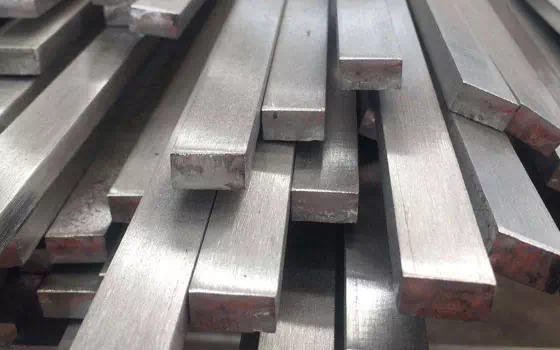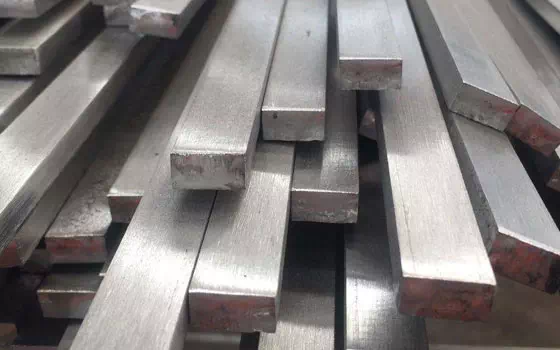Welcome to Zhishang Steel Co., Ltd.
TEL: (Gavin) +86-15665898999 | Email : info@zhishangsteel.com

The classification and introduction of stainless steel flat steel are as follows:
1. Ferritic steel containing chromium more than 14% of low-carbon chromium stainless steel wire, containing chromium dry 27% of any carbon content of chromium stainless steel, as well as on the basis of the above components to add molybdenum, titanium, niobium, silicon, aluminum, tungsten, vanadium and other elements of stainless steel, the chemical composition of the formation of ferritic elements dominate, the matrix structure of ferritin. The microstructure of this kind of steel in the quenching (solid solution) state is ferrite, and a small amount of carbides and intermetallic compounds can be seen in the microstructure of annealing and aging state. Belonging to this category are Crl7, Cr17Mo2Ti, Cr25, Cr25Mo3Ti, Cr28, etc. Because of its high chromium content, ferritic stainless steel has good corrosion resistance and oxidation resistance, but its mechanical properties and process properties are poor, and it is mostly used for acid-resistant structures with little force and for antioxidant steel.
2. Ferritin - Martensitic steel This kind of steel at high temperature for y+a(or δ) two-phase state, rapid cooling occurs Y-M transformation, ferrite is still retained, room temperature organization for martensite and ferrite, due to the composition and heating temperature is different, the amount of ferrite in the organization can be changed in the range of a few percent to dozens of. 0Crl3 steel, lCrl3 steel, 2Cr13 steel with upper limit of chromium and lower limit of carbon, Cr17Ni2 steel, Cr17wn4 steel, and many of the modified 12% chromium thermal strength steel (this type of steel is also called heat-resistant stainless steel) developed on the basis of ICrl3 steel, such as Cr11MoV, Cr12WMoV, CR12WMOV, CR11MOV, CR12WMOV, and many other steel numbers. Crl2W4MoV, 18Crl2WMoVNb, etc. belong to this category. Ferritic-martensitic steel can be partially hardened by quenching, so it can obtain high mechanical properties. However, their mechanical and technological properties are largely affected by the content and distribution of ferrite in the tissues. This kind of steel belongs to two series of 12~14% and 15~18% according to the chromium content of the composition. The former has the ability to resist the atmosphere and weak corrosive media, and has good shock absorption and small linear expansion coefficient; The corrosion resistance of the latter is comparable to that of ferritic acid-resistant steel with the same chromium content, but to a certain extent, it also retains some shortcomings of high chromium ferritic steel.
3. Martensitic steel This kind of steel is in the y phase zone at the normal quenching temperature, but their y phase is only stable at high temperatures, and the M point is generally about 3OO ° C, so it is transformed into martensite during cooling. This type of steel includes 2Cr13,2Cr13Ni2,3Cr13 and some modified 12% chromium hot strength steel, such as 13Cr14NiWVBA, Cr11Ni2MoWVB steel and so on. The mechanical properties, corrosion resistance, process properties and physical properties of martensitic stainless steel are similar to those of ferritic-martensitic stainless steel containing 12~14% chromium. Because there is no free ferrite in the structure, the mechanical properties are higher than the above steel, but the heat sensitivity is lower during heat treatment.
4. The carbon content of the desiccation point of martensitic carbide steel Fe-C alloy is 0.83%. In stainless steel, the S point is shifted to the left by chromium, and steel containing 12% chromium and more than 0.4% carbon (Figure 11-3) and steel containing 18% chromium and more than 0.3% carbon (Figure)3) are hypereutectoid steel. This kind of steel is heated at the normal quenching temperature, and the secondary carbide cannot be completely dissolved in austenite, so the quenched structure is composed of martensite and carbide. There are not many grades of stainless steel belonging to this category, but some stainless steel with relatively high carbon content, such as 4Crl3, 9Cr18, 9Crl8MoV, 9Crl7MoVCo steel, etc., 3Crl3 steel with a partial upper limit of carbon content is quenched at a lower temperature, and such a structure may also appear. Due to the high carbon content, although the above three steel grades such as 9Cr18 contain more chromium, its corrosion resistance is only comparable to that of stainless steel containing 12~14% germanium. The main uses of this type of steel are parts requiring high hardness and wear resistance, such as cutting tools, bearings, springs and medical devices.

5. Austenitic steel This kind of steel contains more elements that expand the y zone and stabilize austenite, which are y phase at high temperature, and have austenitic organization at room temperature because the Ms point is below room temperature when cooling. 18-8, 12, 20, 25-18-20-25 mo chromium nickel stainless steel, such as replacing parts of the nickel with manganese nitrogen and low nickel stainless steel such as Cr18Mnl0Ni5 Cr13Ni4Mn9, Cr17Ni4Mn9N, Cr14Ni3Mnl4Ti steel and other all belong to this category. Austenitic stainless steel has many of the advantages mentioned above, although the mechanical properties are relatively low, and ferritic stainless steel - like can not be strengthened by heat treatment, but can be deformed by cold working, the use of work hardening to improve their strength. The disadvantage of this kind of steel is that it is more sensitive to intergranular corrosion and stress corrosion, which needs to be eliminated by appropriate alloy additives and technological measures.
6. Austenite-ferrite steel This kind of steel due to the expansion of the y zone and stable austenitic elements of the degree of action, not enough to make the steel at room temperature or very high temperature with pure austenitic structure, so austenite-ferrite complex phase state, the amount of ferrite also due to composition and heating temperature can be changed in a large range. There are many stainless steels in this category, such as low-carbon 18-8 chromium-nickel steel, 18-8 chromium-nickel steel with titanium, niobium and molybdenum, especially ferrite can be seen in the structure of cast steel, in addition to chromium-manganese stainless steel containing more than 14 to 15% chromium and less than 0.2% carbon (such as Cr17Mnll), and most of the chromium manganese nitrogen stainless steel currently studied and has been applied. Compared with pure austenitic stainless steel, this kind of steel has many advantages, such as high yield strength, high resistance to intergranular corrosion, low sensitivity to stress corrosion, small tendency to produce hot cracks during welding, good casting fluidity, and so on. The disadvantage is that the pressure processing performance is poor, the point corrosion tendency is large, the C-phase brittleness is easy to produce, and the weak magnetism is displayed under the action of strong magnetic field. All of these advantages and disadvantages are derived from the ferrite in the tissue.
7. Austenitic-martensitic steel The Ms point of this type of steel is lower than room temperature, and it is austenitic organization after solution treatment, which is easy to form and weld. Martensitic transformation can usually be performed by two processes. First, after solution treatment by 700~800 degrees heating, austenite due to precipitation of chromium carbide and into a metastable state, Ms point rises above room temperature, cooling into martensite; Second, after the solution treatment, the austenite is cooled directly between Ms and Mf points, so that the austenite is transformed into martensite. The latter method can obtain higher corrosion resistance, but the interval time from solution treatment to cryogenic cooling should not be too long, otherwise the strengthening effect of cryogenic cooling will be reduced due to the aging stabilization of austenite. After the above treatment, the steel is then aged at 400~500 degrees, so that the precipitated intermetallic compounds are strengthened step by step. The typical steel numbers of this kind of steel are 17Cr - 7Ni -A1, 15Cr-9Ni-A1, 17Cr-5Ni-Mo, 15Cr-8Ni-Mo -A1 and so on. This type of steel is also known as austenite-martensitic aging stainless steel, and because in fact, in addition to austenite and martensite, there are different amounts of ferrite in the organization of these steels, it is also known as semi-austenitic precipitation hardened stainless steel.

Zhishang Steel has always been a pioneer in custom steel and special supplies, and has been recognized for its efforts in enhancing work efficiency and product quality. In addition to ISO9001:2015 certification, we also adhere to strict quality policies and proprietary procedures. If you have any questions, please contact us to provide the best type of product solution for your pre-painted, coil coating metal process, we will closely support after-sales service to ensure that your subsequent problems can be solved in a timely manner, if you have any questions, please send email to info@zhishangsteel.com, we look forward to serving you.

Zhishang Steel, specializing in domestic steel products trade, warehousing, processing and other services. The team has four service teams: Shandong Zhishang Steel Co., LTD., Shandong Zhiyiheng Trading Co., LTD., Tai 'an Zhishang Economic and Trade Co., LTD., Shandong Zhishang Steel Structure Co., LTD. Mainly engaged in steel coil, coated, stee···